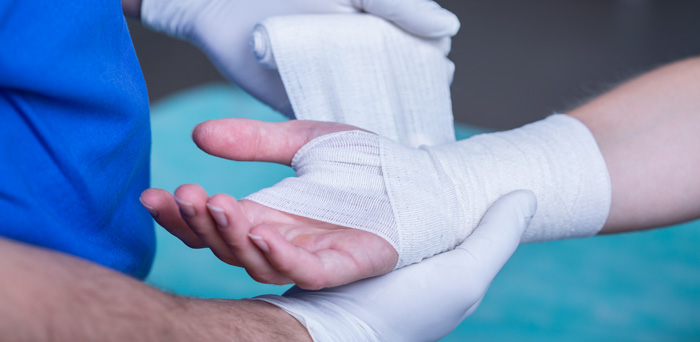Wound Care at Home
Definitions
Wound:
a cut or a break in the skin. Sometimes there will be dressings on your wound.
Drainage:
fluid that comes from your wound.
Steps to Caring for Your Wound
Get the Right Supplies
Depending on your wound, you may need certain kinds of supplies. Supplies needed for most dressing changes include:
- Clean hands
- Cleaning product like mild soap and water or saline (salt water)
- Gauze
- Tape
Remove the Old Dressing
Dressings should be changed once a day. You also need to change your dressing when it is damp, "soiled" (dirty), or falling off. Gently lift the edge of your dressing, making sure to hold the skin around your wound to prevent pulling.
Once the dressing is removed, check to see if there is redness and swelling. Look at the amount of drainage on the dressing and check for a bad smell.
Clean and Dry Your Wound
Follow these steps to clean your wound:
- Wash your hands.
- Gently clean the skin around your wound with warm water and mild soap (or saline, if your nurse or doctor suggested it). A small amount of blood is normal.
- Rinse the wound itself with water and gently pat dry.
Put on a New Dressing
These steps are to be followed for most simple wounds (example: those from surgery that are healing well).
- Place clean, dry gauze over your wound.
- Cover the damp gauze with dry gauze.
- Use tape to hold the gauze in place.
- Put all of the dirty and old dressing supplies in the garbage.
- Wash your hands.
Once there is no more drainage from your wound, there is no need to cover it. Leaving the dressing off when there is no drainage will help your wound heal quicker.
Stitches and Staples
Stitches will often dissolve (disappear) by themselves. Some do need to be cut out. Staples and stitches are usually removed 10-14 days after they are put in. Facial stitches are often removed sooner. Your discharge summary will tell you the exact day for your staples or stitches to come out.
Please see your family doctor or go to a walk-in clinic to have them taken out. A staple remover will be given to you when you leave the hospital. Please take it to your appointment.
Bathing and Showering
You are able to shower when you get home unless your nurse or doctor said something different. Avoid baths until your doctor gives you the "ok". You may rinse the wound with mild soap and water or you can leave your dressing on and change the dressing after your shower.
When to Call Your Doctor
It is important you know the signs and symptoms of infection so you can get help. Call your family doctor or your Sunnybrook doctor if you notice any of these changes to your wound:
- Redness that increases over hours and/or spreads more than ½ inch from wound
- Much more pain than usual
- Significant swelling
- A lot of bleeding (not stopped by applying pressure to the wound with gauze or bandage)
- Getting larger or deeper
- Drainage or pus is increasing, becoming thick, tan, green, yellow, or smells bad
- You have a fever of higher than 38°C (or 100.5°F)






